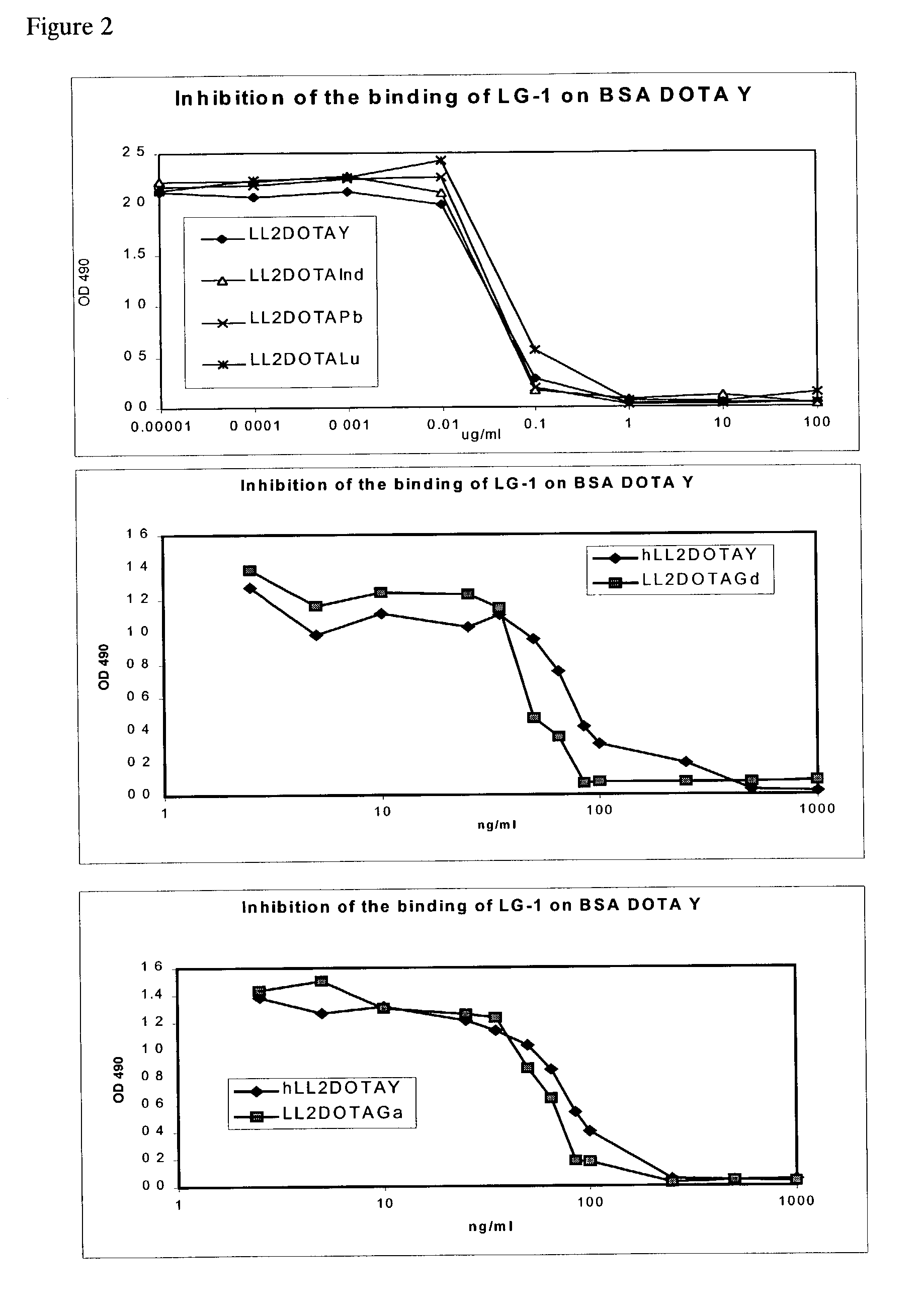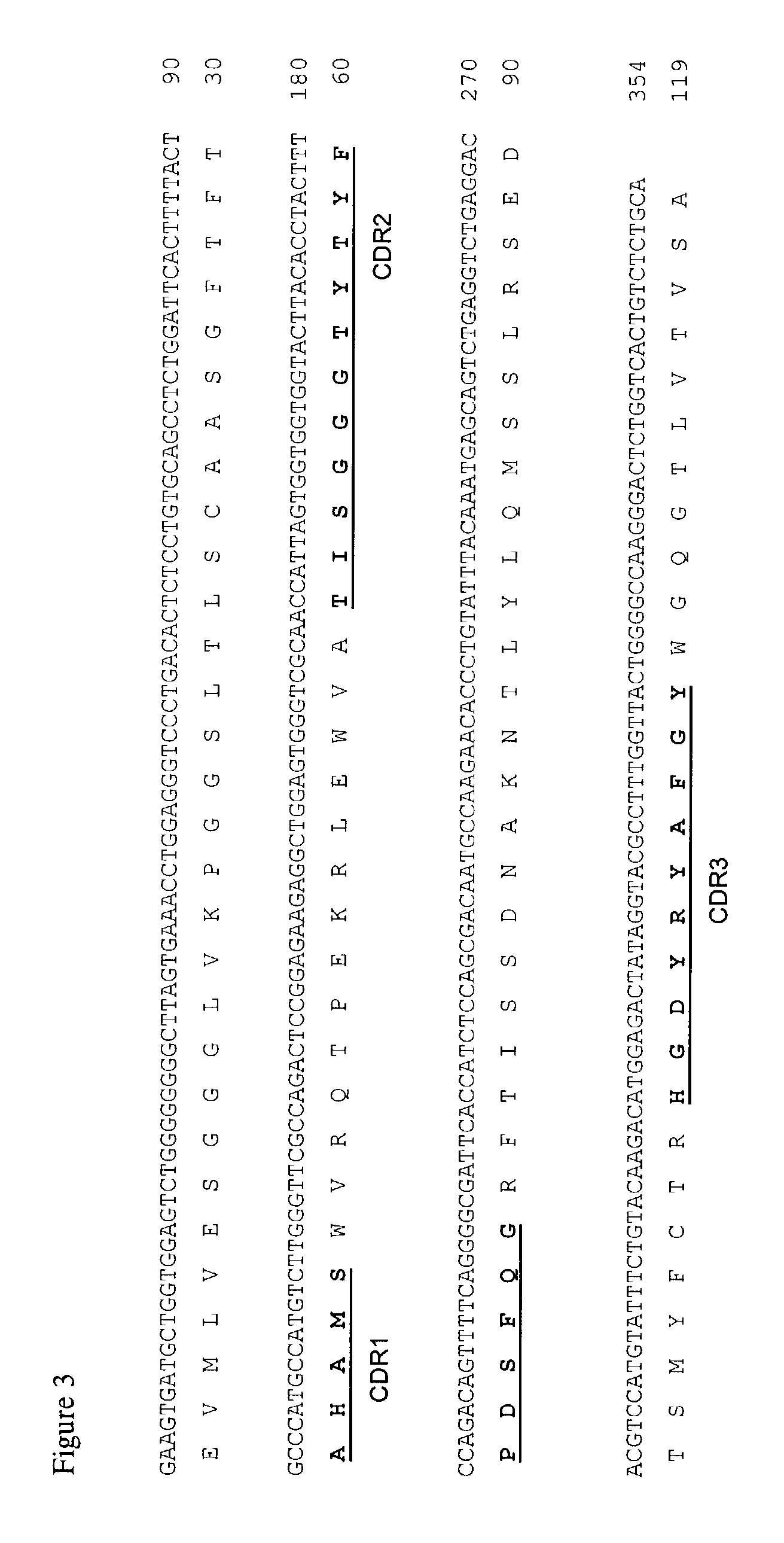Anti-DOTA antibody
a technology of dota and antibody, applied in the field of anti-dota antibody, can solve the problems of ineffective radiometal use, based on and containing chelating agents, and poor clearance pattern,
- Summary
- Abstract
- Description
- Claims
- Application Information
AI Technical Summary
Problems solved by technology
Method used
Image
Examples
example 1
Preparation of hLL2-DOTA Conjugate
[0112]Humanized LL2 mAb is sequentially buffer-exchanged with 20 mM DTPA / 0.25 M ammonium acetate, pH 7.0, 0.25 M ammonium acetate, pH 7.0, and 0.1 M potassium phosphate-0.1 M sodium bicarbonate, pH 8.5 in a series of diafiltrations. Activated DOTA is prepared (45 min at 4° C.) using a mixture of DOTA, sodium bicarbonate, N-hydroxysulfosuccinimide and 1-ethyl-(3,3-dimethylamino)propyl carbodiimide in 10:30:10:1 molar ratios. Activated DOTA is then added to hLL2 in ˜90-fold molar excess, the pH of the solution is re-adjusted to 8.27, and the solution is gently stirred at 4° C. for 18 h. The conjugation mixture is then subjected to a series of diafiltrations with 0.25 M ammonium acetate pH 7.0 and 0.25 M ammonium acetate, pH 5.4. The final product, hLL2-DOTA conjugate, is sterile-filtered and stored at 4° C. The DOTA content is determined by a known metal-binding assay (Meares, CF., et al. Anal. Biochem. 142:68-78, 1984). Briefly, this involves reactin...
example 2
Preparation of an Yttrium Complex of the hLL2-DOTA Conjugate
[0113]For this, a DOTA conjugate of humanized LL2, with an average DOTA-to-hLL2 molar substitution ratio of 2.8-to-1 is used. A 49 mM solution of yttrium chloride (YCl3) in 50 mM hydrochloric acid is prepared using yttrium chloride hexahydrate (of 99.999% purity). An aliquot of this YCl3 solution (0.05 mL) is buffered with 0.3 mL of 0.25 M ammonium acetate pH 5.4. The DOTA conjugate of hLL2 (2 mL; 16.7 mg) is mixed with 0.238 mL of the buffered yttrium (approximately 15-fold molar excess) and heated at 45° C. for 30 minutes. This is followed by an additional 15-minutes of heating, subsequent to a DTPA-quench, using 0.248 mL of 0.1 M DTPA pH 6.7. The solution is cooled, and purified on two successive spin-columns (“centrifuged size-exclusion chromatography”) of Sephadex G50 / 80 in 0.1 M sodium acetate pH 6.5. The final eluate is sterile-filtered. Matrix-assisted laser desorption ionization [MALDI] mass spectral analyses of bo...
example 3
Preparation of a Lutetium Complex of the hLL2-DOTA Conjugate
[0114]A 49 mM solution of lutetium chloride in 50 mM hydrochloric acid is prepared using anhydrous lutetium chloride (99.99% purity). The metal complexation procedure, involving hLL2-DOTA conjugate and buffered lutetium chloride, and the purification are carried out as detailed in Example 2 for yttrium. MALDI mass spectral analyses of both the uncomplexed hLL2-DOTA conjugate and lutetium-chelated conjugate gives a mass difference of 555 Daltons (151,837 for hLL2-DOTA versus 152,392 for hLL2-DOTA-lutetium), with an error rate of 0.2% in this mass range.
PUM
| Property | Measurement | Unit |
|---|---|---|
| concentrations | aaaaa | aaaaa |
| temperature | aaaaa | aaaaa |
| pH | aaaaa | aaaaa |
Abstract
Description
Claims
Application Information
 Login to View More
Login to View More - R&D
- Intellectual Property
- Life Sciences
- Materials
- Tech Scout
- Unparalleled Data Quality
- Higher Quality Content
- 60% Fewer Hallucinations
Browse by: Latest US Patents, China's latest patents, Technical Efficacy Thesaurus, Application Domain, Technology Topic, Popular Technical Reports.
© 2025 PatSnap. All rights reserved.Legal|Privacy policy|Modern Slavery Act Transparency Statement|Sitemap|About US| Contact US: help@patsnap.com



